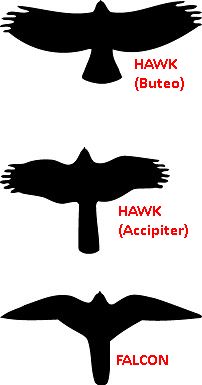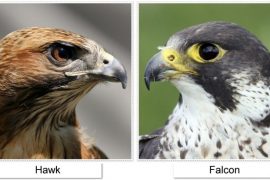Difference Between Falcon And Hawk
Difference between Falcon and Eagle. Telling the difference between a falcon and a hawk is a common identification problem, so common that people often ask me for help.
Today I’ll tell you how to identify the birds yourself.
Right off the bat I’m going to narrow the scope. In western Pennsylvania you can see up to nine hawk and three falcon species depending on time of year and habitat. To make this manageable I’ll address the most common identification question faced by city folks: Is this bird a peregrine falcon or a red-tailed hawk?
First, ask yourself several key questions.
Is it a bird of prey? Birds of prey eat meat so they have hooked beaks (see the tip of the beak) and talons (big claws). If the bird does not have these features it’s neither a falcon nor a hawk and you can stop right there.
What time of year is it? Peregrines and red-tails live in western Pennsylvania year round so the time of year doesn’t eliminate either bird due to migration. However identification is more challenging in June and early July when the juvenile peregrines are flying around town.
Where is the bird? In what habitat? Is it in the city on a building? (Could be either a peregrine or a red-tail) In the suburbs? (likely a red-tailed hawk) On a bridge? (either bird) On a light pole over the highway? (likely a red-tail) In a tree? (likely a red-tail) Standing on your picnic table? (likely a red-tail) Standing on the ground? (likely a red-tail) …But in June a juvenile peregrine might be found in some of the “red-tail” places.
Is the bird in the human zone? Is the bird perched close to humans and doesn’t even care about them? If so, it’s probably a red-tailed hawk …but is it June?
Hawk vs Falcon vs Eagle
Falcons‘ heads are usually short and rounded, whereas hawks, including accipeters, buetos, and eagles, have pointed heads.
Size and Shape
Most birds of prey fall into four major categories. (Northern Harrier, Osprey, and kites are a few exceptions.) These are the core attributes for each:
- Buteos are the large, broad-winged, short-tailed lugs with spare and labored wing beats.
- Accipiters are small, narrow-tailed forest dwellers with short, rapid, bursting flaps, punctuated by a glide.
- Falcons are slender- and pointy-winged speedsters with steadier wing flaps.
- Big Black Birds (eagles and vultures) are the super-size, darker-plumed titans that make spare use of their wings.
Complexion
Once you’ve sorted your groups, it’s time to narrow down the candidate species. Look for specific features—though fine distinctions in plumage might still be hard to pin down. For instance, the signature double ‘stache on an American Kestrel’s face may not be so obvious, so rely on its overall paleness to help distinguish it from the slightly larger and darker female and juvenile Merlin.
Motion
Manner of flight can also be a defining feature. The American Kestrel’s flight is batty and flat, for example, while the Merlin’s wing beats are fast, powerful, and piston-like. Kestrels float when they glide; the heavier Merlins sink. Peregrine Falcons, on the other hand, have shallow, elastic wing beats—you can practically see the motion rippling down the falcon’s long and tapered wings.
As the bird approaches, make sure to test your hypothesis; other clues will become more obvious as the distance closes. And don’t worry, even the experts get fooled. It’s what keeps them coming back, season after season.
What does it look like?
Red-tailed hawks are bigger than crows. They are white on their chests and speckled brown on their heads, faces, wings and backs. Their throats are white but their faces are brown all the way to their shoulders. They have brown hash mark stripes on their bellies (low, between their legs). Only adult red-tailed hawks have rusty red tails. Juveniles have brown tails with horizontal stripes.
Adult peregrines are smaller than red-tailed hawks, about the size of a crow but bulkier. Adult peregrines are charcoal gray and white. Their backs, wings and heads are charcoalgray, their chests are white and their bellies and legs are heavily striped (horizontally) with dark gray. Their heads are dark gray and their faces are white with dark gray sideburns called malar stripes. Peregrines have malar stripes; red-tailed hawks do not.
When it’s flying, does it have “fingers” on the tips of its wings?
Did you see it flying? Hawks (and eagles and vultures) have “fingers” on the tips of their wings. Falcons have pointy wings.

What’s this thing about June?
In June in Pittsburgh juvenile peregrines leave the nest and learn to fly. Immature peregrines are brown and cream-colored instead of gray and white like the adults. They have no white on their chests and the stripes on their bellies are vertical instead of horizontal.
Newly fledged juvenile peregrines may do almost anything, including perch in the human zone. Because they are brown you can’t use those easy color cues you use for adults.
Here is a photo comparison of an immature red-tailed hawk (on the left) versus an immature peregrine (on the right). Though similar in color, they still look very different. The young peregrine’s belly is completely striped.
What is the likelihood of seeing either bird? Peregrines are rare. Red-tailed hawks are the most common hawk in North America.
So you’re usually right if you say it’s a red-tail. You’re unlikely to see a peregrine near ground level in Pittsburgh. That’s why we get excited about peregrines.
Falcons Facts and Information
Falcons belong to the family of the genus Falco. Falcons are known for their speeds when they are fully mature. They use their beak to attack their prey.
- Falcons are highly populated bird and can be found all over the world except Antarctica.
- Falcons can adapt in any circumstances and hence we can find them living in almost all kind of habitats. Whether it is desert, arctic or grasslands they can be easily found in all type of surroundings.
- There are around 40 species of falcons living all over the world.
- The normal lifespan of falcons varies from 12-20 years whereas in some cases falcons can also live for up to 25 years.
- The largest species of the falcon is Gryfalcon whose length is around 20-25 inches (50-63 cm) and weighs around 2 to 4-1/2 pounds (0.9-2 kg).
- Falcons are carnivorous in nature and their diet depends upon the rodents, fish and small insects.
- They have long wings and a medium sized tail and they are mostly dark brown in colour whereas few species are grey as well.
- They are known to hunt during daytime and hence are known as diurnal birds.
- Falcons are wide-known for their eyesight and can see up to 8 times clearer than a normal human eye.
- Falcons are very fast flying birds. The peregrine falcon can fly with a normal speed of 200 mph (320 km/h) while diving. In certain cases, it has been found that falcons can also reach a speed of up to 242 mph (389 km/h).
- Female falcons are usually larger than male and both the mates are known to take care of their offspring.
Hawk Facts and Information
Contrary to the Falcons, the Hawks belong to a number of genes. The Accipiter hawks are most commonly found on earth hence it is the largest genus of hawks. Hawks are more clever prey birds than falcons and they do a sudden attack on their prey. They are known for their long tails.
- Similar to falcons they are also widely populated and can be found all over the world except Antarctica.
- Hawks can also adapt in any kind of habitats hence you will find them in all kind of environmental conditions. Whether it is arctic, desert, grasslands you can find them everywhere.
- Hawks have more than 270 species on the earth.
- Just like the Falcons their sizes also differ from species to species. They can be as long as 22 inches and can weigh up to 5 pounds.
- Similar to the Falcons, the females are usually larger than the males.
- They sharp bill is their weapon while killing their prey. They also use the same to tear apart their prey.
- Hawks are also widely known for their great eyesight and can clearly locate their prey from a distance of up to 100 feet.
- Hawks have one special characteristic that they can distinguish between different colours which many other animals can’t.
- Similar to the Falcons they also hunt in the daytime and hence are known as a diurnal animal.
- Hawks are not specific about their diet and can eat anything that comes their way. They can eat rodents, frogs, snakes, other reptiles and other birds as well.
- Male hawk can perform aerobatics for up to 10 minutes and are widely known for their dance performance in the air.
- They mate with the same partner unless and until one of them dies hence fall under the category of monogamous animals.
- They normally have a lifespan that varies from 13-20 years whereas there are certain cases in which hawks had survived for 25 years.

